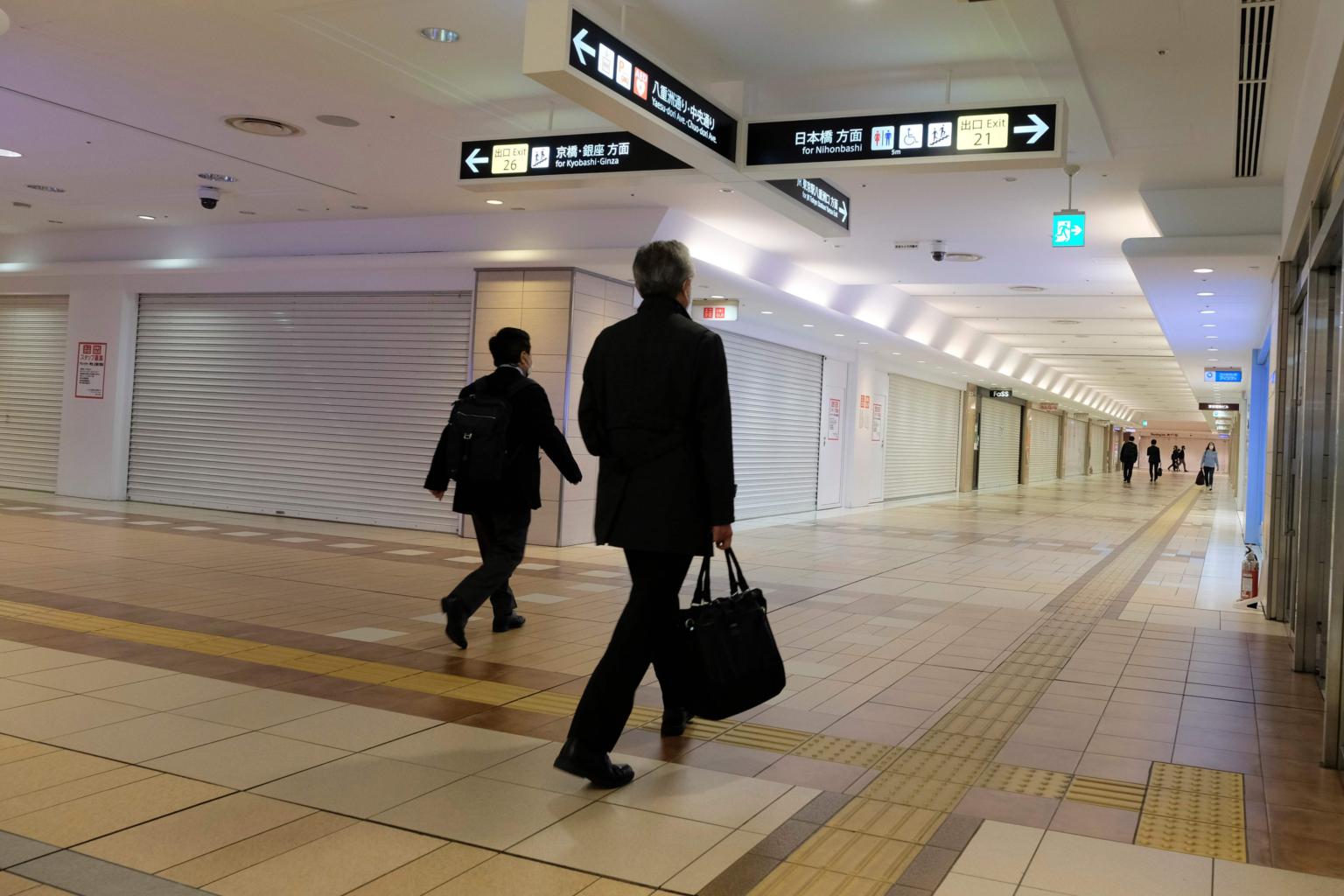'Toothless' Japan lockdown shows some tentative signs of success
Sign up now: Get insights on Asia's fast-moving developments

Commuters walk past closed shops in an underground shopping mall in Tokyo on April 15, 2020.
PHOTO: AFP
Follow topic:
TOKYO (BLOOMBERG) - With Japan in its second week under a state of emergency, the latest data suggests that a "lockdown" without legal power has still been able to contain citizens' movements somewhat, offering some tentative encouragement for the country's bid to slow the coronavirus.
From GPS data to train station usage, the latest figures show people's movements have slowed since Prime Minister Shinzo Abe declared a month-long emergency in Tokyo and six other prefectures.
While infections are still on the rise, with cases now totalling around 8,000, the nation has so far still avoided the "explosive" surge seen in some other countries. Mortality from the virus remains puzzlingly low.
The number of new cases reported in Tokyo has also been ticking lower, with 127 daily cases confirmed on Wednesday (April 15). The city of 14 million people is yet to top 200 daily infections, making it one of the least-affected global hubs worldwide.
But Japan continues to conduct testing at a much slower pace than other countries, making the picture frustratingly unclear on whether the nation is headed for a slow containment, or is on the cusp of a major outbreak.
Japan's state of emergency has been criticised as toothless for lacking punishments for those who don't follow stay-at-home requests. Some bars are allowed to remain open. Still, data from Apple's Maps application shows a drop in routing requests in Tokyo. The same trend is repeated across areas that have declared an emergency.
Numbers from rail companies show the footfall of people passing through ticket gates in stations across the nation is massively down from a year ago, showing how the emergency declaration is impacting rail commuters.
GPS information from mobile apps compiled by Agoop show marked declines in people's movements at major transit hubs in Tokyo, using April 7, the day before the state of emergency went into effect, as a baseline.
But the drop was less than 40 per cent in some areas including in the vast Shinagawa transport hub, indicating more needs to be done. Abe in his emergency address urged citizens to cut contact with others by at least 70 per cent or 80 per cent, warning infections in Tokyo could surge to 80,000 in a month if current rate holds.
And one encouraging but puzzling data point remains Japan's low overall mortality, by far the lowest in the Group of Seven countries. Compared even to nations like Germany that have earned plaudits for their response, the number of deaths in Japan is minuscule. While various theories exist, there's no consensus to the underlying reason behind this number.
"It's not just one factor, it's multiple factors," said Yoko Tsukamoto, a professor of infection control at the Health Sciences University of Hokkaido. "I don't think Japanese medical care is better. Compared to the US, we do have universal insurance, so people don't wait to go to the hospital." She also pointed to lower obesity rates as a possible factor, and highlighted the unexplained lower mortality rate in Japan during the Spanish Flu a century ago.
Kenji Shibuya, a professor at King's College London and a former chief of health policy at the World Health Organisation, also points to healthcare access. But he says the lack of testing is leading to many undiagnosed pneumonia cases and that Japan is still in the early phase of the outbreak.
"Testing is not catching up" and Japan is still at the point where it can manage the control of the outbreak, he said, saying the country has "more to come." Not all signs are encouraging. While central transport hubs have cleared out and businesses have voluntarily closed, many neighbourhoods in Tokyo remain busy, far from the empty thoroughfares seen in other nations.
Even as the virus claimed more than 100 lives, including a national celebrity, many in the country of more than 120 million have yet to see firsthand the impact of the virus.
And that complacency may be the biggest risk. If no measures are taken, the nation-wide death toll may rise to around 400,000, Japan's health ministry estimated, as reported by Kyodo News on Wednesday. The report doesn't represent the official view of the ministry, Chief Cabinet Secretary Yoshihide Suga said.
Government officials are hoping that voluntary compliance will be enough to both reduce the spread of the virus and keep the economy afloat, and that Japan won't have to resort to draconian lockdowns like in other countries. The country had yet to see an "overshoot", or explosion in the number of cases, Abe said in parliament Tuesday, insisting that containment measures hadn't been too late.

